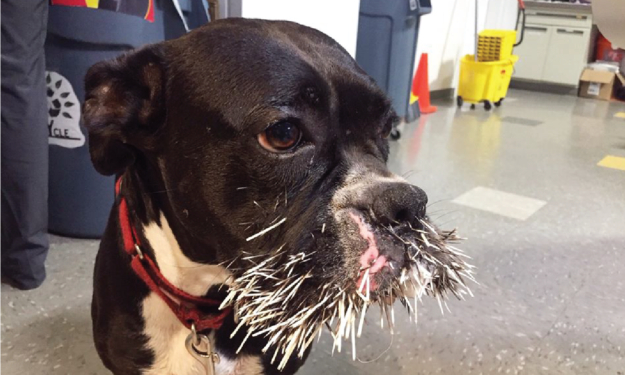
Porcupines have approximately 30,000 sharp quills on their bodies, and although porcupines might seem vicious, porcupines are timid creatures. Contrary to popular belief, porcupines don’t go out of their way to quill people or pets, such as dogs and cats. Those who are quilled by a porcupine are quilled because they came into direct contact with a porcupine, and it was only trying to protect itself. People and pets cannot be impaled by a porcupine throwing quills, and with proper care, pet cats and dogs rarely die of being quilled by a porcupine.
If your dog or cat is an unfortunate victim of a frightened porcupine, you should know the best methods of removing porcupine quills and treatment. For the safety of your pet your best choice is to bring them to a veterinarian if possible. There is more to removing a porcupine quill than simply pulling the quill out. The reason porcupine quills must be pulled out with extreme care is because they have sharp barbs which will pull the quills deeper and deeper into the flesh of the unfortunate victim. Quickly removing porcupine quills is paramount. Because of the barbs, porcupine quills require special care in removal since twisting or turning a quill can cause a considerable amount of pain and damage to an already injured dog or cat.
A dog or cat that has been quilled by a porcupine is usually in a great amount of pain, and when animals are in pain they are more likely to bite. Even if your dog or cat would normally never bite, it’s important to muzzle your pet to prevent your pet from biting out of fear. If you don’t have a muzzle for your dog, create a muzzle by closing your pet’s mouth and tying its muzzle firmly with a strip of cloth which is then tied behind the head. A cat will have to be controlled by someone holding them by the scruff of the neck. This may seem cruel, but it’s in your pet’s best interest to remove the porcupine quills as quickly as possible. After gaining control over the victim, using a pair of needle-nose pliers or a forcep firmly grasp the quill as close to the skin as possible, and pull the quill straight out. If it breaks off, or if it is already broken off, a veterinarian might have to remove the quill while the cat or dog is sedated.
After all the quills are removed from your cat or dog, clean the wounds with warm water and antibacterial soap. Dry the area and apply antibacterial ointment. Since pets lick their wounds, ask your veterinarian for a recommendation on the type and brand of ointment to use. Watch the wounds caused by porcupine quills for signs of infection until the wounds have fully healed.
Related Articles & Free Email Newsletter Sign Up
3 Steps to Help Pets Achieve and Maintain a Healthy Weight
Adopt, Don’t Shop: The Importance of Rescuing Animals in Need


Comment here